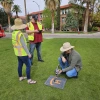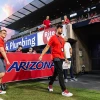Discovering The CATalyst Studios Technologies: A Space For Creative Innovation
A discovery series on the diversity and uniqueness of technology services at UArizona

Inside the University of Arizona Libraries CATalyst Studios, visitors are captivated by the contemporary design housing cutting edge technologies, including a Virtual Reality (VR) Studio, Sound Studio and Green Screen Studio, Data Studio and the Maker Studio. In each studio, there is lots of technology and boundless opportunities for creative learning. As characterized on the Success District webpage, “The entire east wing of the Main Library ground floor inspires formal and informal learning through technologies such as virtual/augmented reality, data visualization, and fabrication equipment.”
The CATalyst Studios is where students, faculty and researchers engage with library staff for consulting on projects and to transform their learning content into interactive learning experiences of all formats. Perhaps the foremost of several CATalyst Studio spaces is the Maker Studio where everyone is welcome to creatively construct in a welcoming environment.
Stepping into the Maker Studio, Niko Sanchez, Digital Design and Fabrication Specialist, introduces the two most well-known fabrication technologies of 3D printing and laser cutting. “Our entire facility was built around the utilization of the laser cutters, because they're our most expensive machine and it requires the most amount of infrastructure to utilize.” With the full redesign of the library’s ground floor, the Catalyst Studios was designed with having laser cutters in mind. Pointing to the massive air duct conduits for the venting system, Niko explains, “It’s all the ventilation that allows us to have and utilize the laser cutters.” The laser cutters along with 3D printers and sewing machines are the three major fabrication technologies that are supported in this space.
He explains that 3D printing comes in two formats, “FDM technology where spools of plastic are melted down and then layered onto a bed, creating a very light object, and resin 3D printers, which use a laser shining at a very thin layer of liquid resin to build layers. Resin printing allows for highly detailed results but can be very brittle.”
Niko comes from a teaching background where he taught machining to high school students for several years before coming to the university. This background provides a natural inclination to mentor the students on using and maintaining the various fabrication tools in the CATalyst Maker Studio. “So that way they're learning on-the-job technical skills that they can either utilize in their majors or just gain use of as a person who wants to be aware of the electronics. If something breaks, they will have the confidence to attempt to fix it.” He even wrote the protocol for training students on the CNC machines to give them the full spectrum of using the tools. The majority of the technology in the CATalyst Maker Studio is CNC controlled. (computer numerical control, comes from the machining industry and is the automated control of tools by means of a computer). This computer control includes most of the tools used by students in the Maker Studio such as the 3D printer, laser cutter and sewing machines.
Glancing around the space filled with student designed crafts, it’s easy to understand how imagination is the only limitation here. The space is used for student projects affiliated with coursework and for hobbyists alike. Sometimes student clubs will visit the Maker Studio to use the 3D printers or sewing machines for specialty items for their club. More recently the laser cutter was used for student graduate gifts using excess materials that otherwise would have no use.
The students who really like to take ownership of the Maker Studio come in and can leverage two different types of roles. “One is a student internship where they do a focused project using the technology in the space for an entire semester and then they present it for course credit. Then we have students working here and instead of getting course credit, they get paid as a student worker.” Niko sees many students who are taking agency and want to commit to the space. Joy Chepoghisho and Josue Valenzuela are two of such students we found working in the studio during a recent visit.
Joy Chepoghisho is a sophomore who used the various CATalyst studios to create a cinematic fashion show for a class project. “I cast models, and then we filmed all around Tucson to create a story-like fashion show in cinematic form.” When asked what tools she used for her show, she waved her hand across the room smiling, “I used the sewing machine, the laser cutter, the 3D printers. I kind of used everything here.” She has a minor in fashion and career goal that the CATalyst studios have had a huge impact on. Describing her experience with the CATalyst studios, “It's like a big resource. Everybody here knows everything. So, I can just go there and can ask people, do you know how to do this? Can I do that? It’s great.”
Josue Valenzuela is a second-year mechanical engineering student, who used several fabrication tools to create a miniature steam engine. “I modeled it on SolidWorks (3D design software) and then I used my resin 3D printer to make it just so it would run on the air pressure from the air compressor that we have in the wood shop.” Being the end of the spring semester Josue is already planning to spend his third year in the Maker Studio too. “Just having all the tools for everything I could ever dream of here is kind of nice. Like anytime I want to make something—make something up, prototype something, or if I have any idea, I can just come here and make it.” Speaking of his student workers, Niko agrees that anytime they are not helping someone, they are working on their own arts and craft projects. He’s seen some exceptional projects come to fruition such as Josue’s miniature working steam engine.
The CATalyst Studios are designed, managed and occupied primarily by students. But on any given day you will find researchers in the data studio, fine arts classes using the greenscreen video studio or faculty members creating a podcast in the audio studio. Most of all, it is a welcoming space for anyone wishing to explore their imagination. “The things that people know here are great resources themselves and the students never run out of ideas.” Niko explains, “So, you can talk to anyone around CATalyst and they all have so many ideas or so many projects they're working on, and they will easily share their thoughts.”
Looking back to a story published on the March 19, Discovering University Library Technologies, the staff who support the CATalyst Studio are not part of the Libraries' technology unit; they are part of the Student Learning & Engagement (SLE) department. Within the Maker Studio SLE staff are actively assisted by the Technology Strategy & Services (TeSS) department to make sure the CNC and other computing equipment work as needed within the context of campus IT security. This is often challenging due to many manufacturers assuming private local networks and elevated permission use and not enterprise infrastructure with restricted access controls. This collaborative effort is one of many examples where TeSS has a critical role in the eight other departments at the Libraries.










